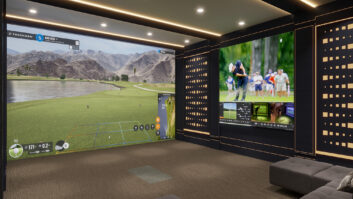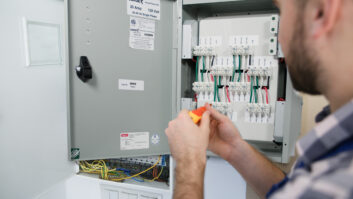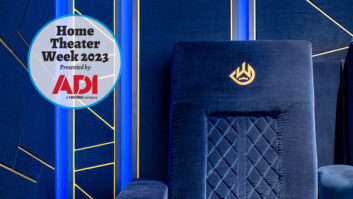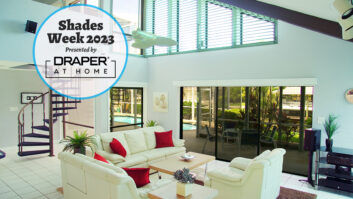Whole-house audio is in demand, and it is easy to understand why. Its appeal lies in the hearts of music lovers who enjoy having audio throughout their home and would rather not have stacks of audio components or speaker boxes visible in the room; they just want the music, not the equipment trappings that are the joy of audiophile gearheads.
According to data collected by the Consumer Electronics Association in 2005, 15 percent of all new homes have multi-room audio. That compares roughly to 12-percent penetration for 2004. These figures are in line with statistics gathered by Parks Associates, an independent research firm that often surveys the CEDIA channel. Bill Ablondi, an analyst with the firm, noted that for 2005, sales of whole-house audio systems (including installations), reached $1.98 billion.
With those kind of returns, competition is heating up, not only among multi-room audio manufacturers, but also for everyone involved in home technologies. There is now more overlap between companies marketing home control and those in multi-room audio, security, and home theater. One company staking its claim in the field is NetStreams, whose digital distribution approach to audio stands in stark contrast to the traditional centralized, analog model. We were founded on the vision that, in the future, every device in the home is going to have its own unique IP address, explained Petro Shimonishi, NetStreams vice president of marketing.
NetStreams has two distinct audio systems. The entry-level Musica system operates over Cat-5 or better, cabling to keypads in each zone, which have onboard amplifiers to drive the speakers. One level above Musica, is the companys flagship, fully IP-based DigiLinx system with intercom functionality. DigiLinx sends music streams across an Ethernet network, allowing for plug-and-play integration and expandability. Both systems are now offered with custom skins for their touchscreens. Using the dealer setup program, an installer can drag and drop different user interface styles in each room.
The distributed network approach has its pros and cons. An IP-based network, unlike a matrix switch-based system, can have a virtually unlimited number of zones. Theoretically, youre limited to 1.8 millions rooms, Simonishi said, but I have yet to meet anybody whos even come close to that. However, a key issue with audio distribution over a network is the difficulty of keeping the music in all of the zones tightly synchronized. To address this potentially annoying problem, NetStreams is developing a patent-pending technology to maintain close synchronization within the network.
Niles Audio taps into modularity with its range of multi-room audio solutions, including the IntelliControl ICSa six-source, six-zone receiver, which features a source bay that accepts any combination of six source modules (e.g. AM/FM tuner, a satellite radio tuner, CD player, etc). User control is handled via Niles touchscreens, wall-mount keypads, or iRemote, the RF-based wireless handheld remote control.
Niles product manager Jim Novak said that during IntelliControls development, a great deal of effort was concentrated on simple, speedy integration and configuration for the installer. By taking the modular approach with the IntelliControl ICS series, Niles is expanding beyond the audio distribution box, to offer many of the audio sources as well. It should help the company capture a larger piece of the overall system sales, while for dealers it minimizes or eliminates the integration task.
Uniquely, Audioaccess, a division of speaker manufacturer JBL, has introduced its Whole House Entertainment Network (WHEN) system. It is built around the AVR21EN receiver that can simultaneously function as a 7.1-channel home theater A/V receiver as well as a multi-source, multi-zone audio system. The receiver is supported by an outboard WHEN AVHS1 A/V hub (connected via a Cat-5 cable) and Audioaccess KP21 keypads, which provide zone control. The keypads have built-in digital power amplification to drive local speakers.
With the popularity of Apples iPod portable digital player, almost every multi-room audio equipment manufacturer has been compelled to find a way to integrate one or more iPods into its systems. If portable music players are hot as sources, what about Microsofts Windows XP Media Edition media server? Although MCE has not garnered a lot of attention from whole-house audio manufacturers, it is in a great many of the same homes residential integrators serve. With Intels strong push of its Viiv technology, two industry giants are now sounding the horn for PC-based music and video entertainment.
We hope Microsoft Media Center is going to be a stimulant for increased sales, said Andy Lewis, product manager for Russound. Our gear can be a nice citizen within the Microsoft Media Center space. To take up residence within MCE, Russound has formed an alliance with Exceptional Innovation, developer of Life|ware which leverages MCEs media server features and extends the Media Center PC into home control. Weve picked up who we think is going to be the strongest horse in the race, said Lewis of the partnership, which has been in the works for two years. Theyve got drivers written for the majority of our gear.
Gordon van Zuiden, president of Las Gatos, California-based integration firm cyberManor believes that MCE will have a place in multi-room audioalthough not as the distributor of the audio as he sees it as a single-zone solution. Instead, van Zuiden points out that if whole-house audio is viewed as just another interface the user has to learn in order to use it, then the value of MCE becomes more apparent as part of a solution. MCE talking to a Russound CAV6.6 can do a lot of great things, so maybe that is the perfect marriage, van Zuiden said. In this scenario, the MCE would serve as a source, while the Russound system takes on its traditional role as the multi-zone distribution system.
Russound is not the only CE manufacturer willing to tap into MCEs potential. NetStreams has hinted that it will have an interface to use with the platform with an announcement to come as soon as this month, while Niles Audio is currently exploring ways to use the format in a whole-house audio setting. We believe that the Internet is going to be a pipeline to deliver [music] content, and were going to be able to hook into somebodys PC and use it as a media server, Novak predicted. Whether its running Microsoft Windows Media Center Edition or a secondary application, theres content stored on your hard drive that you may want to access from anywhere in your house, and we believe we need to have the capability to do that.
It used to be that graphically rich touchscreens were the province of high-end home installations, while lower-end homes got simple, inexpensive keypads for control. Now driven by the proliferation of digital sources, users at all price levels need more powerful ways to navigate through their sources and content. Couple this with an interest by many vendors to penetrate the large mid-market, and we see a shift toward packaging heretofore luxury-level features into more economical product offerings.
Users are bombarded with media choices, said Russounds Lewis. In a multiroom audio setting the user interface is their access to all of this content. Design should focus on taking the confusion out of it by creating products that are simple to use and instantly understood. Russound has invested a great deal of research and development into the user interface issue, including using outside experts to conduct usability studies. One product of that work is the UNO-TS2 color on-wall touchscreen and new tabletop version.
SpeakerCraft has introduced the Music on Demand Experience (MODE), a new wall-mount display and controller designed for the middle market. MODE bridges the gap between simple keypads and graphical touchscreens. MODEs key features include a 3.5-inch color LCD screen to display source and program information, a scroll wheel to navigate through menu options, a keypad, and a larger dedicated volume control knob.
Crestron is also turning its gaze to the mid-market with its Adagio multi-source audio line. At the heart of Adagio is 2-Series control, which allows the system to function as both a multi-room audio system and a home automation controller. Dealers can pitch this as another differentiation point for the Adagio line, as it positions customers for easy future expansion into home control.
Alan R. Frank ([email protected]) is a networking consultant and freelance writer.







